Do Carmo walks across the terrain he has known since his childhood as if he doesn’t even notice the ground. When a group of archeologists moves about his yard examining the soil and quite effortlessly uncovering piece after piece of dirt-covered pottery—the remains of vessels used by Indigenous peoples centuries ago—he reacts like someone who has witnessed this scene many times before. “We’ve got a lot of that here,” says the man, who for decades has tilled this ground to plant cassava, bananas, and anything else that wants to grow. Do Carmo has seen extraordinary things. He steps lightly toward the house and comes back to show something off. Nestled in a small transparent plastic bag is a pointed object the size of the palm of a hand, kept carefully by him for some years now. Vinícius Honorato, one of the archeologists, smiles as he takes it out of the bag. It is an arrowhead chiseled from stone that may be more than 7,000 years old.
Do Carmo’s precious arrowhead was found a few yards away, right next to a mango tree, turned up after heavy rains had muddied the ground. Even though he didn’t know what it was, he sensed there was something special to the object, so he decided to store it safely on a shelf. In 2017, when Vinícius visited his community in the Iriri Extractive Reserve in the state of Pará, Do Carmo showed the archeologist his discovery and had his suspicions confirmed: it was indeed a chiseled stone artifact. “A very rare kind here in the Amazon,” the researcher says.
News of the find spread quickly. One day, some strangers in a motorized canoe stopped a few yards from his house. They walked up to Do Carmo and asked to see the object. “I’ll give you 300 reais [about USD 60] for it right now,” said one man, pulling a wad of bills from his pocket. Do Carmo didn’t stop to think. “I’m not selling it!” was his reply. Sitting on a stool in his backyard, he explains: “My father used to say, ‘Son, there were other people on this land before us.’ I wonder, do you suppose this is from one of their arrows? It’s something that has a history.”
Do Carmo knows history is priceless.
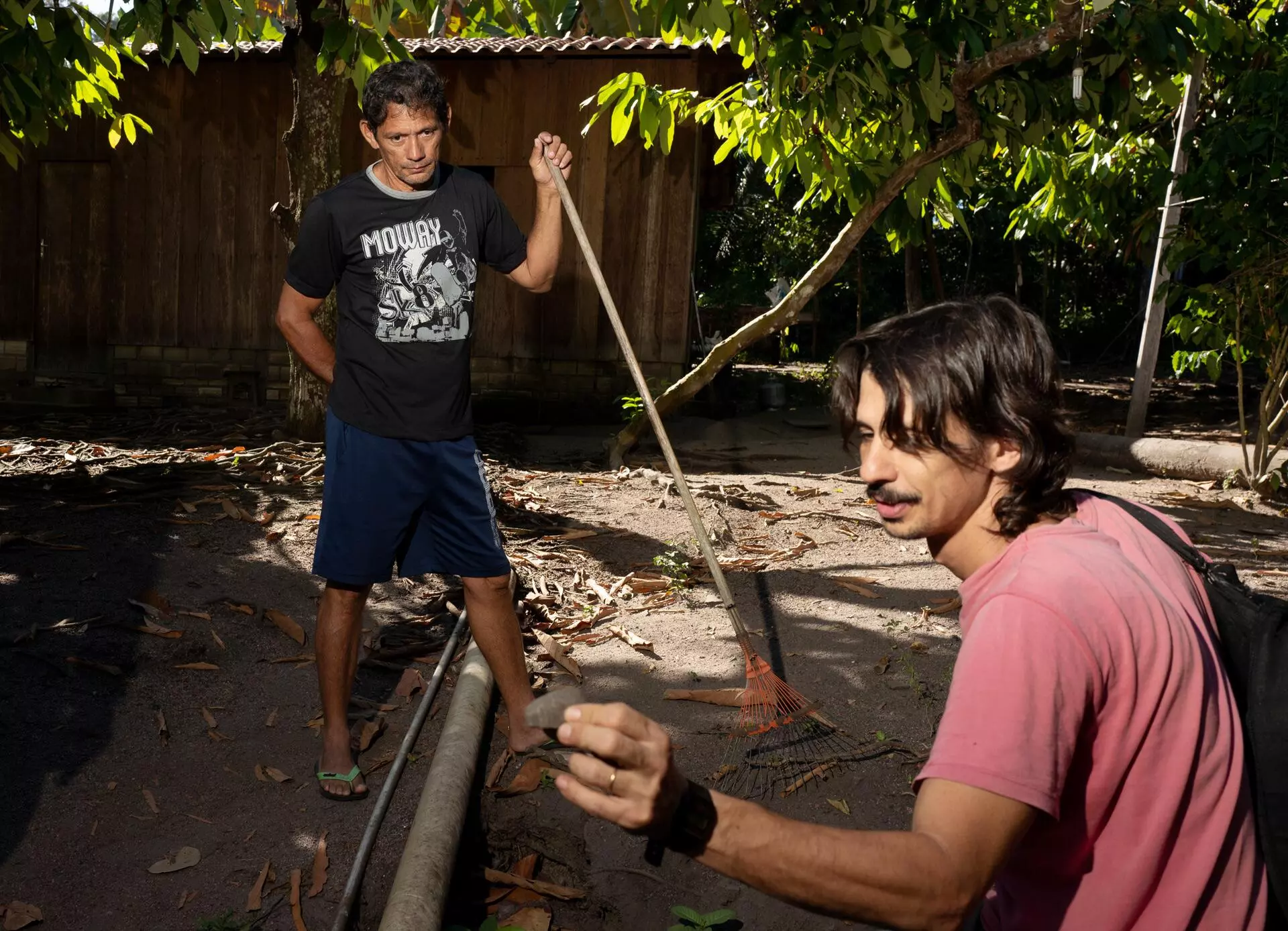
Do Carmo observes a piece of Indigenous pottery held by the archeologist Vinícius Honorato. This resident of Terra do Meio once filled a 20-liter bucket with traces of the past found on his land. Photo: Alessandro Falco/Sumaúma
Manoel do Carmo Neves de Sousa, a 57-year-old rubber tapper, grew up in the community of Manelito, named after the place’s first resident, Do Carmo’s father, who settled there on the banks of the Iriri River, a crystal-clear branch of the Xingu where immense boulders jut from the waters to create a dreamlike landscape. The history of Brazil—and of this land that was widely inhabited long before the Portuguese invasion—is told by these waters and also by the centuries-old trees in Do Carmo’s yard, the soil where he walks and plants, and an indentation in a rock along the riverbank where you can imagine someone in the past kneeling down repeatedly to pound away with stones and make tools. This history is also told through Do Carmo’s ancestors, who arrived here from the arid Brazilian Northeast in the late nineteenth century during the first rubber boom and became beiradeiros—riverside dwellers who have developed their own unique way of life, residing in communities along the beira, or edge, of the river. It was here, a few yards from where the arrowhead surfaced, that the group of archeologists decided to open a clearing and commence digging. What stories might the soil tell?
These scientists are part of the project Amazônia Revelada—the Amazon revealed—which aims to identify archeological sites in the Brazilian portion of the rainforest and reconstruct a past that has long been written in the colonizers’ ink. The project also intends to reveal the diversity of the occupation of the Amazon, a region where 12,000-year-old artifacts have been unearthed but whose history is still being built, both by surviving Indigenous peoples and by rubber tappers and their descendants. Driven by economic and political interests, many governments have tried to erase the idea that the land has been occupied continuously, instead fostering an image of the rainforest as an inhospitable, dangerous place that would be more useful if cleared—a notion still under attack today by initiatives like the marco temporal (historic cut-off point) thesis, whose proponents advocate the demarcation only of land that was occupied by Indigenous peoples in 1988, when Brazil enacted its latest Constitution.
Identifying new sites in the Amazon is also important so the rainforest itself, which helps regulate the planet’s climate, can gain a further layer of protection. Archeological sites are protected under Brazilian law and should be held under the guardianship of public authorities. “This is a political archeology project,” says Bruna Rocha, who, like Vinícius, is a professor at the Universidade Federal do Oeste do Pará and one of the coordinators of the project, funded by National Geographic and the Darwin Initiative. “We are facing a climate crisis. We ask ourselves: what can archeology do to contribute to this fight?” Bruna wonders.
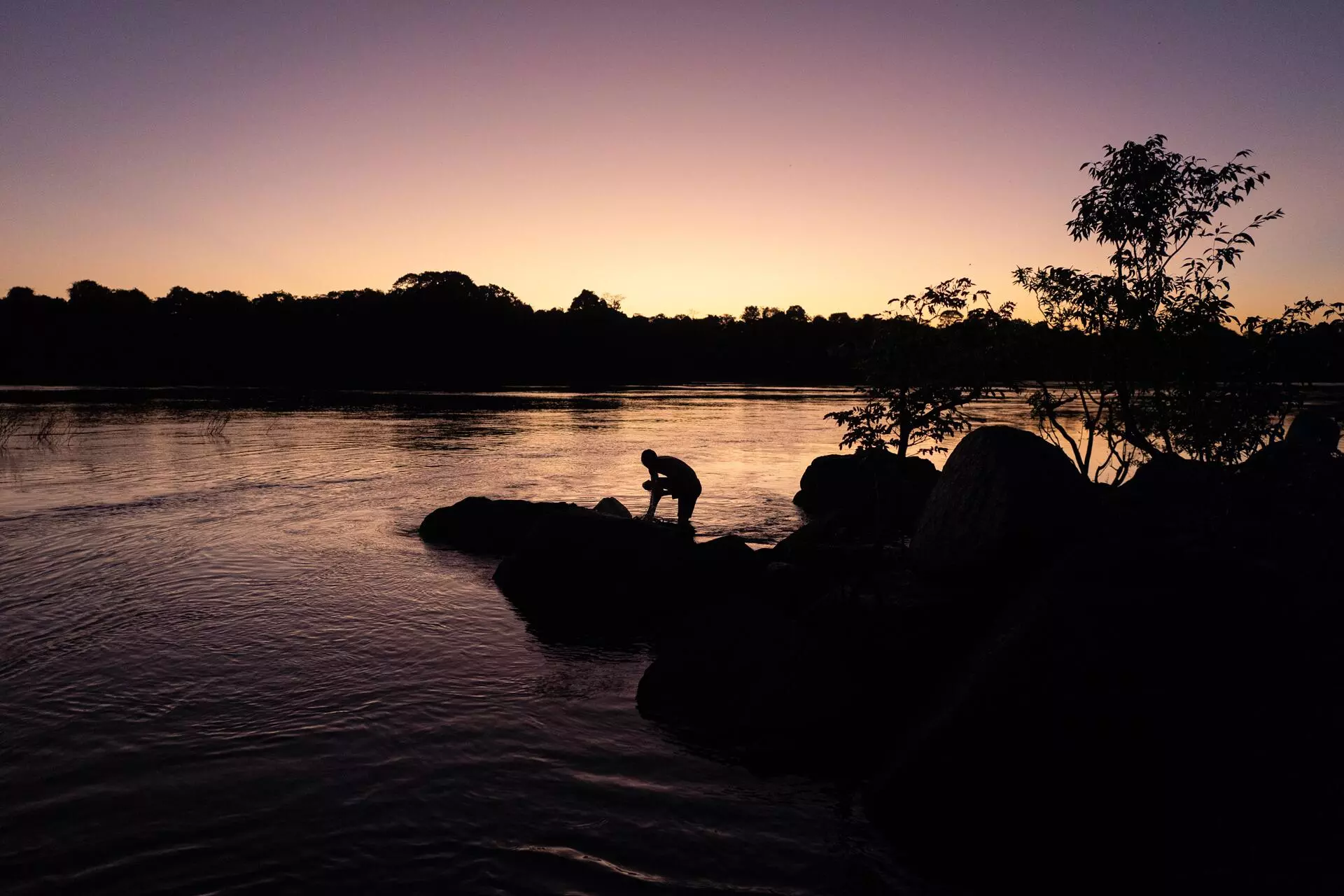
A young man from the community of Manelito, in the Rio Iriri Extractive Reserve, bathes in the river at sunset. Photo: Alessandro Falco/Sumaúma
The practical part of the project got underway in July of this year in communities in Terra do Meio—or “Middle Earth,” as the 108,000-square-mile area of land lying between the Tapajós and Xingu rivers is known. This fieldwork will combine the knowledge of Indigenous peoples and beiradeiros, like Do Carmo, with the technology known as LiDAR (Light Detection and Ranging). In 2018, LiDAR was used to identify a pyramid buried in the rainforest of Tikal, a Mayan city in northern Guatemala. By the end of 2024, the first phase of the project will map and excavate potential archeological sites in other areas, beyond Terra do Meio, including eastern Acre and southern Amazonas, regions occupied mostly by large ranches and farms; the Guaporé Biological Reserve and Uru-Eu-Wau-Wau Indigenous Territory in Rondônia, home to isolated Indigenous peoples; and other traditionally occupied areas yet to be defined. Communities living where LiDAR will be deployed were consulted and have given their consent, Bruna emphasizes.
Aerial collection of LiDAR data began in Acre in July and researchers are currently analyzing the information obtained. Through the emission of infrared laser beams, LiDAR can make 3D models of the earth’s surface underneath the tree canopy. In other words, it is as if the technology took photographs of the soil after removing all the trees from the forest. For example, this technique enables visualization of earth mounds that may indicate ancient dwelling areas or roads once used by the Indigenous but now overgrown by the forest. “It will help us obtain good maps of past and present occupation,” says Vinícius. The images will also enable researchers to identify potential locations for future excavations.
One LiDAR flight has already detected a geoglyph in the middle of the rainforest in Acre, in this case a square shape with two skinny triangles extending armlike at mid-height. In the 1970s, deforestation began revealing this type of geometric structure dug into the ground. Scientists believe many such geoglyphs are still hidden by the trees. It was first speculated that they had served as forts, but recent research suggests they may have been sacred places where ceremonies were held. The use of LiDAR technology can aid in mapping and expanding our knowledge of these geoglyphs.
Graphic shows what LiDAR can uncover: drag the circle to the right to see the dense forest; drag it to the left to see the geoglyph discovered under the tree canopy
Do Carmo continues walking his land. He holds his lanky body so perfectly erect that his fine-framed glasses balance easily halfway down the bridge of his nose. In front of his house runs the calm river he has paddled ever since he was a boy, going fishing or visiting neighbors. The birds singing in the dense rainforest around him compete with the roosters crowing in his yard. When he cleared the area where his chickens now scratch for food, Do Carmo filled “a 20-liter pail with lots of stuff” he dug up.
“There were a whole bunch of hatchets, one real big one, in one piece,” he says, placing one hand at eye level and the other near his chest. These objects belonging to past inhabitants were given to an Indigenous man from the nearby Tukamã village, a member of the Xipaya people, who live in this territory today. Portrayed in the early records of the white explorers who came to the region in the seventeenth century, the Xipaya were nearly exterminated, first by war with other Indigenous groups and then by the arrival of white men. Forced to flee the region, the Xipaya only managed to return in the mid-1990s. When we visited Do Carmo at his home on that Saturday in July, a small square of earth had already yielded up a large, nearly intact ceramic disc, probably the bottom of a pot used by the Indigenous between 2,000 years ago and the arrival of white men; also found was a cast iron lid, a sign of occupation by rubber tappers between the close of the nineteenth century and first half of the twentieth—side by side, the continuous history of this land’s past, with Do Carmo as its present.
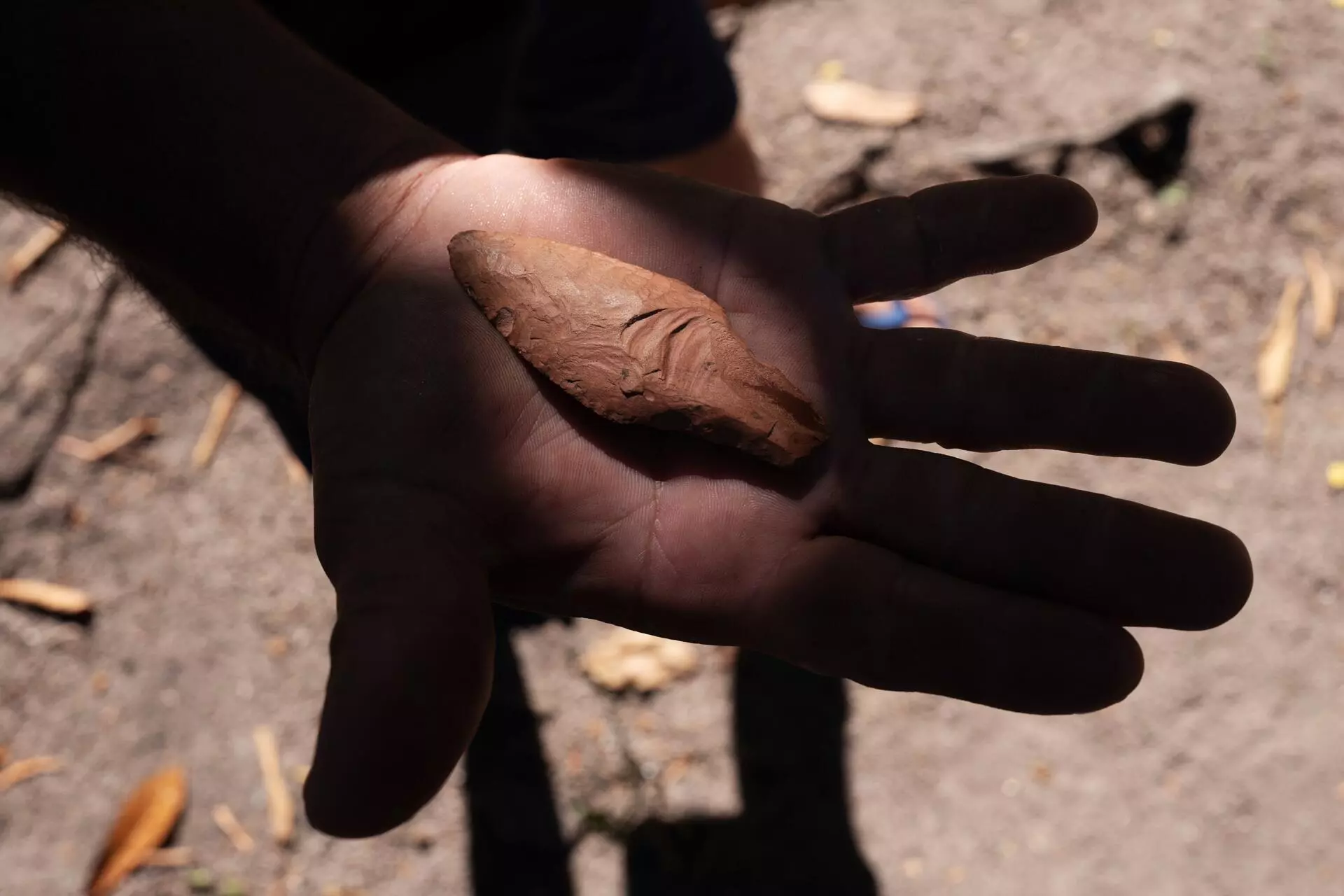
Do Carmo holds the arrowhead he found near his house, in the community of Manelito. Photo: Alessandro Falco/Sumaúma
The soft-spoken ways of this man contrast with the vibrant life of the surrounding forest, where every now and then a group of peccaries will charge by, forcing him to scramble up a tree like a gymnast. The animals are attracted by his gardens, planted on higher ground, farther from the river, where the soil is more fertile, rich in the dark Amazonian earth known as terra preta—in this region also called terra de maloca, or longhouse dirt, in reference to former Indigenous dwellings. This soil was enriched by the presence of the area’s original peoples, according to research conducted in recent years. “We believe this terra preta was formed over time from the disposal of things like straw from houses, food waste, excrement, bones, burials, pottery, feathers, seeds,” says the archeologist Bruna. These areas of Indigenous occupation eventually produced soil rich in organic matter, ideal for the crops planted by Indigenous descendants and also by rubber tappers and beiradeiros.
Research has suggested that after the second rubber boom ended and the system collapsed, around 1945, the rubber tappers, who had until then lived where their bosses dictated, were left to their own devices in the forest and could then decide for themselves where to reside, explains Vinícius. “One question we ask is this: since these rubber tappers were familiar with the environment, to what extent did they leave the places chosen by their bosses and move to areas previously occupied by Indigenous people, sometimes without even knowing it, because they identified an area of plenty left by the inhabitants of the past?” the researcher wonders. Do Carmo’s father, Manuel Alves de Sousa, started working his stepfather’s rubber trees at the age of twelve; when the older man chose to live in this area, he knew his crops would thrive because his boss had planted there before.
The archeologists have opened a second dig in an area of terra preta (black earth) near the garden plots to assess whether Indigenous people did indeed live there, as the hypothesis suggests—and as Do Carmo’s yard seems eager to tell us.

Artifacts found in the community of Manelito. From left to right: ceramic fragment from the Indigenous era; stone object used as an axe; chiseled stone tool; cast iron lid used by rubber tappers. Photo: Alessandro Falco/Sumaúma
Carlos Magno Ataíde da Conceição, 30, wiggles his way into a square hole to scrape away at the earth with an ordinary trowel—an archeology trowel is expensive and not easy to find in Brazil, explains Bruna. Carlos, a senior in archeology at the Universidade Federal do Oeste do Pará and a project volunteer, is working on the second dig at Manelito using the same tool his father and uncle, both bricklayers, have used their whole lives.
Born in the Belém neighborhood of Cabanagem, Carlos is the fifth of six children and a member of the first generation of his family to attend college. He is also among the first wave of Amazonian archeologists in training. The surnames Santos and Silva—grandchildren and great-grandchildren of the Northeasterners who migrated to the Amazon—are now replacing names like Coudreau and von Martius, the foreign scientists who for decades dominated the narrative about the region’s history. Over the years, these white explorers carried much of what they found on these lands back to museums in the United States and Europe, where the objects remain today, mostly housed in storage rooms, far from the eyes of the public and of those who share this history.
“We are Amazonians. We are the descendants of these populations. Most people from poorer generations aren’t familiar with the history of their families. They can’t tell you the names of their grandfathers or great-grandfathers, as people from wealthier classes can. When we use spaces like these, at the university, we’re also getting to know our own history,” says Carlos, who works alongside two other archeology students from the Amazon, Emily Roberta da Silva Santos, 22, and Marlos Douglas Silva Rocha, 20. They spend a month measuring, marking, digging, sifting the earth, and recording and storing each find. Inch by inch, they dig ever closer to their own origins.
By the end, the students, Vinícius, and Bruna have removed more than a dozen bags containing traces of the past, which are then taken to the university for cleaning and analysis. The artifacts include many pieces of pottery, whose styles and graphics may tell us which peoples lived here.

From left to right: Professor Bruna at the dig in Manelito, alongside the students Marlos and Emily (who is protecting her face from mosquitoes); Carlos Magno at work in the second excavation area; Vinícius showing a soil color chart, which helps identify terra preta. Photos: Alessandro Falco/Sumaúma
A group of 19 young beiradeiros approaches their first excavation. They are residents of communities located in Terra do Meio, a region composed of a mosaic of extractive reserves, Indigenous areas, and an ecological station, and these youth are being trained to identify potential sites for future project digs. “This place is very interesting. If you think about the whole history of the Amazon, it’s as if you had a summary here,” Bruna explains to the students, standing next to the dig. “Not far from here, Do Carmo found this arrowhead, which is one of the oldest things you can find in all of South America. There’s a bit of terra preta, these ceramic shards from Indigenous people who lived here before, their stone tools, hatchets. And then the materials that are all about the rubber tapping life, about the beiradeiro life.”
Curious, the young people spread out around the now deep hole, exchanging knowledge with the researchers to help piece together the region’s historical puzzle. “These woods have been here a long time, but if you come and put in a garden, various types of plants you didn’t put in will grow,” says Rafael Ferreira de Souza, 23, looking at the rainforest. “In my community, I picked out a spot and put in a garden. Guava, papaya, wild cassava came up, but I hadn’t planted them,” he says. “A lot of these terras de maloca are like seed banks. There are things stored here that are the product of people who lived here long before,” says Bruna.
As part of the project’s activities, the students had been instructed months earlier to search around their homes for new remains and record what they found on an app installed on their cell phones so the information could be shared with the research team. The finds are divided into time categories defined with the assistance of these young students: the time of the “Indians” (although the more accepted term in Brazil today is Indigenous); of the “bosses,” or heads of rubber plantations; and of the Extractive Reserves established in the region in the early 2000s, during President Luiz Inácio Lula da Silva’s first term of office. Since the beginning of the project they have mapped 160 remains.
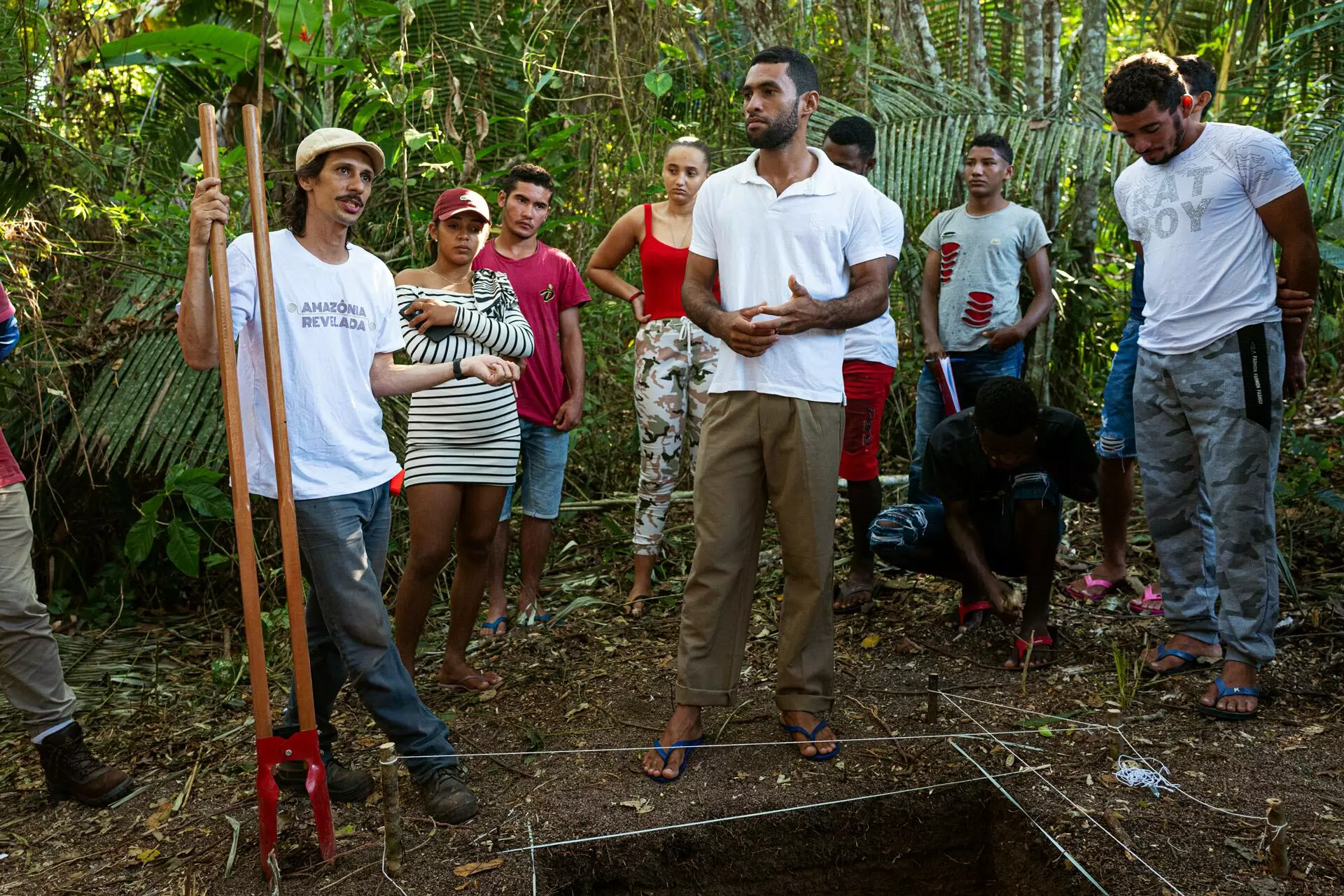
Vinícius shows residents of Terra do Meio the dig site. Rafael Ferreira (center) is curious about the seeds he found in his gardens. Photo: Alessandro Falco/Sumaúma
“Where we live is kind of like an archeological site. You take a step, and you find a shard, a pot. A few days back I found a perfect ceramic pot in front of my house,” says Liliane Santos da Silva, 21.
Sitting under a mango tree, Crislene dos Santos Silva, 17, lists what she has discovered on her land: “My husband found kind of like an arrow, which we think is from Indian times. There was also a hatchet from the rubber tapping era, because before they started cutting [the trees to extract latex] with a knife, they used to cut it with [a metal] hatchet,” she says.
The young participants were selected because they were enrolled in a territorial management course sponsored by the Socioenvironmental Institute (ISA), which covers such subject matter as the importance of archeology and how studying the past can contribute to their fight for the right to this land. Proving that these areas of the Amazon were inhabited by their ancestors or by Indigenous peoples, always in harmony with the rainforest, may be crucial to guaranteeing their permanence here.
“For years, the image of the forest as an enemy to be vanquished was promoted,” Bruna tells the students during one of the project’s classes, held in the community of Manelito. She shows them an advertisement from the time of Brazil’s military business dictatorship (1964-1985), one that commemorates the Trans-Amazonian highway, whose construction generated massive deforestation and decimated many peoples along the way. “The idea was that there was nothing positive about the forest, except the wealth that could be extracted from it, like ore. [The rainforest] was seen only as a place for sourcing products, not a place where there are people,” she says. This line of thinking wasn’t by chance. Just as colonization wiped out many original peoples to make way for the exploitation of the territory, the dictatorship—and the ruralist bloc today—saw forest-peoples as an obstacle to their economic interests. Ignoring the lives of the forest has always been essential to a project that views the Amazon and nature as sources of private profit.
When Europeans invaded the continent, some eight to ten million people were living in the Amazon basin, estimates Eduardo Neves, the archeologist who coordinates the project Amazônia Revelada. Many of these original peoples were killed either by the diseases brought in by colonizers, by enslavement, or in trying to defend their peoples. “When the first scientists began traveling through the Amazon in the eighteenth century, they found the region empty, and its ancient settlements covered by forests. The absence of stone structures contributed to the false idea that took hold over time: the Amazon was empty,” Neves wrote in an article published by SUMAÚMA.
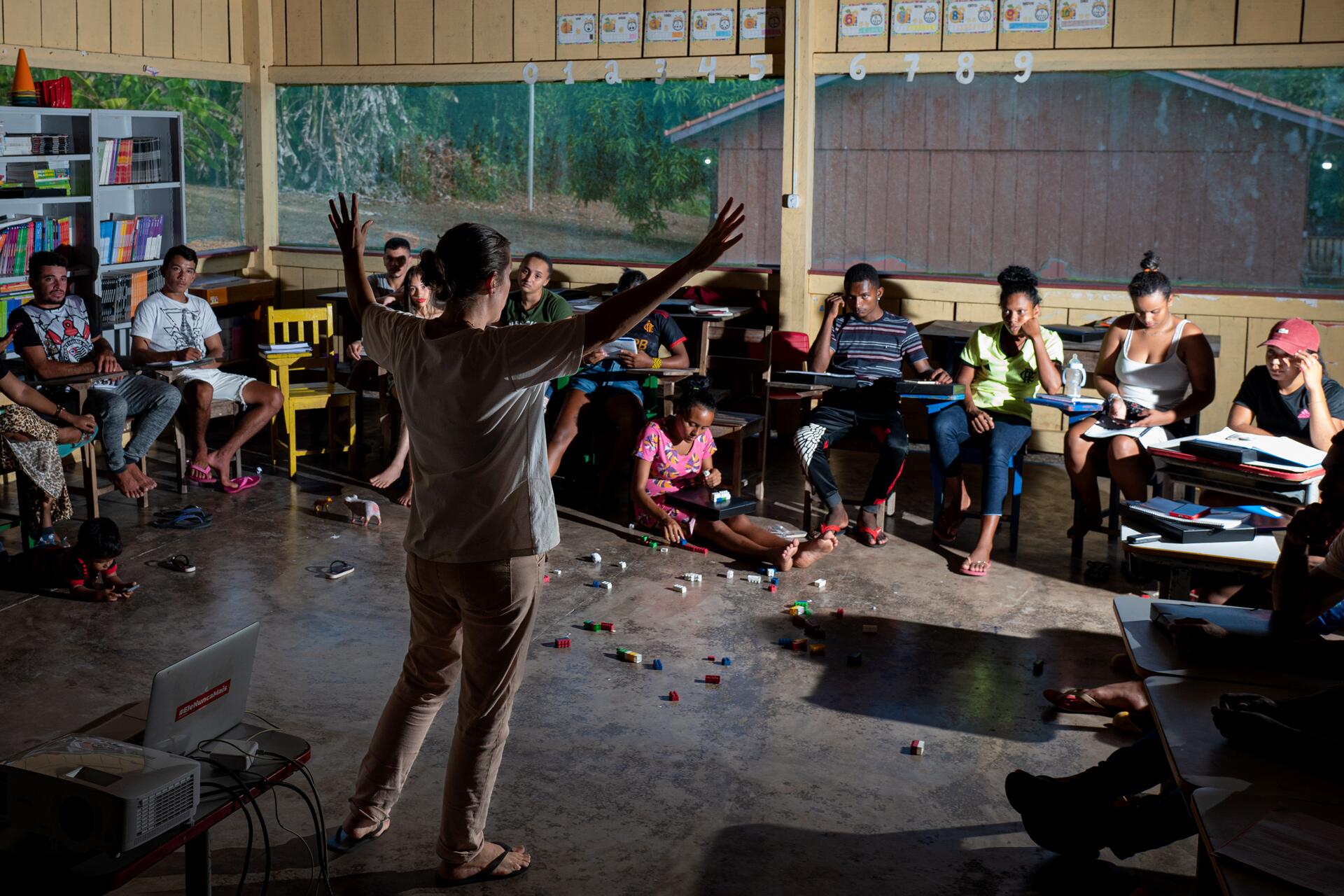
Archeology professor Bruna Rocha giving a class: students are helping identify potential excavation sites in their communities. Photo: Alessandro Falco/Sumaúma
Archeology has been instrumental in demonstrating that the Amazon was an important center of agricultural production, where plants such as cacao and cassava were first cultivated. Along with structures discovered by archeologists in recent years, like embankments, roads, and mounds, the region’s terras pretas—which began to be produced 5,500 years ago in what is now the state of Rondônia and had spread throughout the Amazon basin by 2,500 years ago—offer proof that sedentary populations lived there in communities similar to cities. These peoples left their traces behind and altered the landscape. It is now a consensus among leading scientists that the ancestors of today’s Indigenous peoples planted part of the rainforest.
Leaning against a wooden desk in a room in Manelito, Vinícius looks at the computer screen and points to a colorful drawing by a beiradeiro from Riozinho do Anfrísio, a nearby community where he and the project team had worked the week before. It is an illustrated map where the river appears at the bottom, the residents’ home just above it, then their garden plots (rich in terra preta), and, behind these, a trail leading to Brazil nut groves. This occupation pattern is observed in other communities in the area, including Manelito, where Do Carmo lives. “There are studies that show that in order to have this concentration of Brazil nut trees in one same place, enough to warrant the name ‘grove,’ it is usually associated with human presence. People have to maintain these areas, opening up clearings so the young trees can flourish,” Bruna explains. “We see that the Brazil nut groves lie outside the area of terra preta [where ancient Indigenous peoples once lived and disposed of things]. This makes perfect sense because nobody wants to have a Brazil nut tree right above their house, where the fruit pods or even the tree itself might fall on them,” says Vinícius.
In the rainforest, nonhumans also retell history.
The rubber trees along the trail that Do Carmo still works almost every day recreate these past occupations. He guides the students through the trees, teaching them how to make precise diagonal cuts in the bark to allow the rubber to flow. It takes a bit of strength but not too much, so the rubber tree doesn’t develop a wound. Do Carmo’s rubber tapping knife has a long wooden handle with a short, curved blade and sharp hook on the end. Many of the trees he has known since his childhood bear the marks of hatchets used by his grandfather’s coworkers and by the Indigenous who came before them. An upstretched arm barely reaches these gashes since the passage of time has lengthened the trunks. But the marks of history will always remain, resisting all efforts to erase them.
Fact-checker: Plínio Lopes
Proofreader (Portuguese): Valquíria Della Pozza
Spanish translation: Meritxell Almarza
English translation: Diane Whitty
Photo Editor: Lela Beltrão
Layout and finishing: Érica Saboya
Editorial workflow and copy editing: Viviane Zandonadi
Director: Eliane Brum
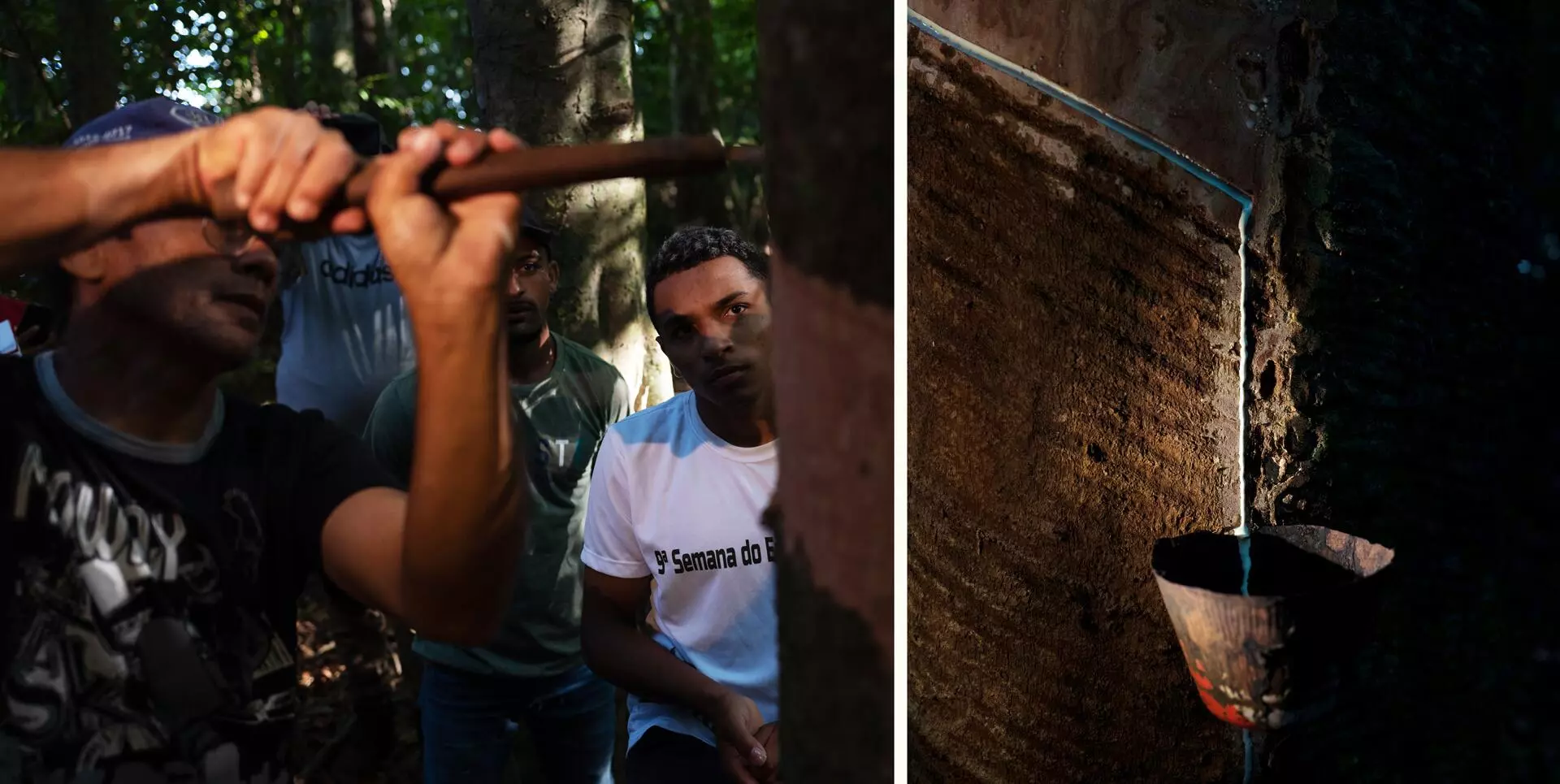
Do Carmo shows students how to cut a rubber tree to extract latex. These trees bear the historical marks of occupation. Photo: Alessandro Falco/Sumaúma





